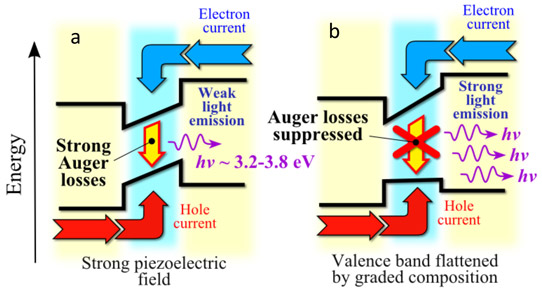- News
19 February 2014
NRL-Technion-Ioffe team outlines roadmap to efficient green-blue-ultraviolet LEDs
Scientists at the US Naval Research Laboratory (NRL) have suggested a method that could significantly increase the efficiency of green-blue-ultraviolet LEDs based on GaInN/GaN, AlGaN/GaN and AlInN/GaN quantum wells. It is reckoned that their approach could enable advances in solid-state lightening and the creation of low-threshold lasers and high-power LEDs (Applied Physics Letters, 25 January 2014 and 26 November 2013 issues).
Epitaxial perfection in the growth of quantum wells has been the key to achieving light-emitting diodes and laser diodes of superior power, efficiency, and performance. Ternary group-III nitride LEDs based on GaInN/GaN, AlGaN/GaN and AlInN/GaN quantum wells now find widespread application in energy-efficient as well as decorative solid-state lighting. But their use in high-power lighting applications is currently hindered by a significant loss in efficiency, even at modest electrical currents, notes NRL. Indeed, the quantum efficiency of the LEDs peaks at relatively low currents - a few tens of amperes per square centimetre - and then steadily drops, by almost half, as the current increases. This droop in efficiency is observed in the visible, blue, as well as ultraviolet spectral regions.
Scientists at NRL's Center for Computational Materials Science, in collaboration with researchers at the Technion, Israel, and Ioffe Physical-Technical Institute, Russia, have created computational models showing that the observed droop effect arises from non-radiative Auger recombination of the injected carriers. The rate of the Auger recombination is proportional to the cube of the carrier concentration. As a result, the non-radiative Auger decay rate grows rapidly with current density, quenching the generation of light.

Schematic of processes responsible for LED operation. Thick black lines show energy band diagram of conventional (a) and proposed (b) LEDs based on GaN/AlN QWs. In conventional GaN/AlN QW LEDs the GaN layer’s polarization field strongly enhances the non-radiative Auger rate, leading to a reduction in photoluminescence quantum yield and hence to efficiency droop with increasing electric current. In the proposed LEDs (b) the electric field acting on holes in the QW is compensated by a gradual composition variation of the variable-gap GaAlN alloy, resulting in a flat valence-band potential. Auger processes are suppressed and no droop effect is expected. (Photo: U.S. Naval Research Laboratory)
To suppress these non-radiative Auger processes, one needs to create quantum wells with a soft confinement potential. Dr Alexander Efros, a senior researcher in NRL’s Materials Science and Technology Division, previously showed theoretically that a softened electrostatic potential prevents carriers from acquiring the momentum necessary for non-radiative Auger processes, and thus suppresses the Auger decay rate. This concept was patented by NRL in March 2013. The latest calculations by the NRL-Technion-Ioffe research team demonstrate that softening the confinement potential - by varying the alloy composition along the growth direction - also completely suppresses the piezoelectric field that normally enhances non-radiative Auger processes in GaN/AlN QWs. The calculations show that the droop effect in such quantum wells can be significantly or even completely suppressed.
In addition to Dr Efros at NRL, research team members include Roman Vaxenburg and Efrat Lifshitz from the Israel Institute of Technology, Haifa, Israel, and Anna Rodina from the Ioffe Physical-Technical Institute, St. Petersburg, Russia.


